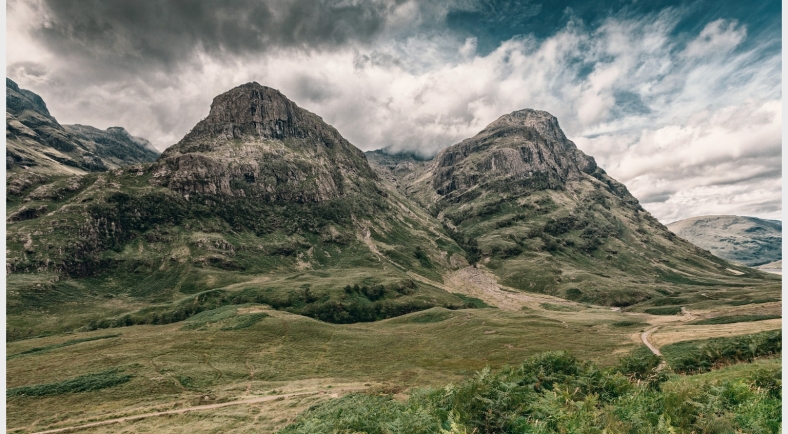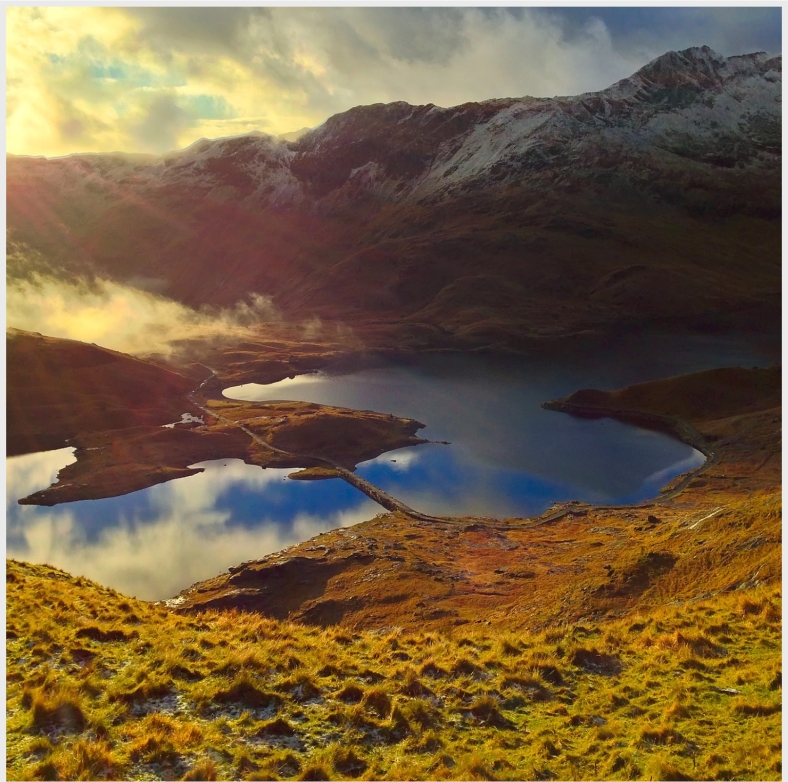Many people have compiled lists of the hills and mountains of the British Isles over the last 130 years, so much so it has become a British hill-walking sport to tick off the various collections, a pastime known as ‘Hill-Bagging’ or ‘Peak Bagging’. In my #RunningtheSummits 1000 Mountain challenge I will need to become a fairly obsessive participant of this activity but there is no definitive 1000 mountains collection so how do I go about compiling such a lengthy list of my own for this challenge?
Mike Knipe has a very amusing detailed blog delving further into this bizarre British pastime featured on the UKHillwalking website.
 Standing on the ‘pointy bit’. CAUTION : always bear in mind, getting down is much tricker than getting up!
Standing on the ‘pointy bit’. CAUTION : always bear in mind, getting down is much tricker than getting up!
It started, as these things do, with the question over a pint or two “What makes a mountain a mountain?”……some time later and after much debate, disagreement and admittedly a little drunkenness, the question had not been adequately answered so I later turned to that font of all knowledge- the modern, universal library……Google!
 Some baffling trigonometry behind measuring a mountains height – points deducted for not showing my workings out!
Some baffling trigonometry behind measuring a mountains height – points deducted for not showing my workings out!
There seemed to be a consensus of agreement that to constitute ‘mountain’ status in Britain a peak needed to be 2000ft (609.6metres) or higher. Question simply answered you might think…..well, no. This was where the clear black and white line ended. Because there are many humps and bumps along a ridgeline for example that can easily be argued to be part of the main summit as opposed to mountains in their own right. In order to make some sense of this jumble of peaks, ridges, bumpy shoulders (technical term!), crags and outcrops various lists began to be compiled to categorise the peaks into orderly groups of hills that could be qualified, quantified and best of all, ‘bagged’. How we British love lists. I am a dedicated list maker myself so this particular, logistical part of the challenge really got me keenly reaching for the coloured marker pens.
My Multi Coloured Map of English Mountains and hills – happy hours of plotting on the Viewranger App!
Now if a person wanted to climb a large number of the highest mountains in Britain they really need not look much further than Scotland which hosts way more than its fair share of fabulous high and wild places. But my objective with the Running the Summits challenge was to showcase a broader selection of peaks throughout the Isles and to highlight the fact that Yes, we DO have mountains in England.
 Some fairly ‘mountainy’ looking peaks in Britain
Some fairly ‘mountainy’ looking peaks in Britain
So the first list that I decided to use for my 1000 mountains compilation is the ‘Hewitt’s’ , an anacronym of sorts…Hills of England, Wales and Ireland over Two Thousand feet. This list was compiled by Alan Dawson and the contenders were originally quite aptly called ‘Sweats’. The additional criteria that secures a peaks place on the Hewitt list is a topographical prominence of 100ft (30’ish metres). In simpler terms that’s basically the amount of height the summit has over the surrounding ground, i.e. the ‘pointy’ bit that makes it stand out! There are over 500 Hewitts spread out across England, Wales and Ireland so my 1000 mountain list was immediately half full.

I then added ‘Nuttalls’, named after John and Anne Nuttall who compiled the list published in their books ‘The Mountains of England and Wales’ – all of which also qualify for mountain status by height, but these peaks only need 50ft (15m) of ‘pointy bit’ at the top to qualify as a Nuttall. Whilst all Hewitts are also Nuttalls, the full Nuttall list of 444 mountains adds a further 126 summits to my compilation.
 Ingleborough – one of the highest peaks in Yorkshire and part of the popular Yorkshire 3 Peaks Challenge, an all round top day out followed by cake and a pint of tea at the Pen y Ghent Cafe in Horton-in-Ribblesdale – just get round before they close!
Ingleborough – one of the highest peaks in Yorkshire and part of the popular Yorkshire 3 Peaks Challenge, an all round top day out followed by cake and a pint of tea at the Pen y Ghent Cafe in Horton-in-Ribblesdale – just get round before they close!
During my research I also came across an opinion that as well as peaks over 2000ft, a peak over 1000ft, if it had considerable topographical prominance, i.e. stuck out like a sore thumb, totally dominating its surroundings, it could, loosely, in some circles be considered a mountain. I have since misplaced my reference for this argument but I am sure it was hidden somewhere in the pages of the mountainguide.co.uk which, incidentaly lists 10,000 peaks throughout the British Isles and is a fabulous source of reference and hill-shaped vital statistics, if you like that sort of thing. One list that would include such attention grabbing peaks is the ‘Marilyns’ (the name a pun to the Scottish ‘Munro’s’ – there is no such list as ‘the Mansons’!) This extremely voluptuous list of 2010 peaks in the British Isles, also compiled by Alan Dawson includes all hills with a prominence of at least 500ft (152m) (i.e. ones with extremely outstanding ‘pointy bits’) regardless of their overall height. I felt some of these peaks deserved a place in my list, after all – my challenge, my rules!
 Pen y Ghent lost in the clag – a Hewitt, Nuttall AND Marilyn all in one!
Pen y Ghent lost in the clag – a Hewitt, Nuttall AND Marilyn all in one!
All the Marilyns of England, Wales and Ireland above 2000ft are by default also Hewitts, but for the purposes of my list of 1000 I will be including an additional number that stand between 1000ft and 2000ft in England and Wales qualifying as ‘Mini Mountains’. This classification group also gives me the chance to travel a little more widely around England too as all of the 2000ft+ mountains bar two are situated in the National Parks of northern England.
 They might not be mountains but Chrome and Parkhouse Hills are as pointy as a witches hat.
They might not be mountains but Chrome and Parkhouse Hills are as pointy as a witches hat.
I’m not sure exactly how many Marilyns I will include yet as I am still scoping out the illegal ones – those hanging out on private land – which I will probably be avoiding, not least because carrying bolt cutters would heavily encroach upon my ‘fast and light’ policy.
Then of course when we look to the Lake District which hosts by far the majority of English mountains we have that wonderful list, the ‘Wainwrights’, which just brings a romantic sigh from the mouths of hill walkers everywhere – a list of 214 Lakeland peaks, just to confuse matters further, locally known as ‘fells’. These 214 fell tops are a definitive group with no statistical criteria. They were illustrated and written about by Alfred Wainwright in his collection of guides to the lakeland fells for no more than aesthetic reasons and constitute some of the most beloved mountains and hills of the region.
 The view from Haystacks – Alfred Wainwright’s favourite fell
The view from Haystacks – Alfred Wainwright’s favourite fell
Wainwright bagging is also a very popular activity, which would probably have been much to the chagrin of the mild mannered, shy man himself who cared little for any form of rushing around in the hills, list ticking or bagging. I have long admired his simple, uncomplicated lifestyle and love and knowledge of the Lake District fells so it seemed fitting to finally reach the summits of all of these places that I have previously only dipped into, as a part of this challenge.
 Kirk Fell looking non too inviting…
Kirk Fell looking non too inviting…
Many of the Wainwrights fall into other categories – Hewitts or Nuttalls giving them full mountain status for the purposes of my list. Some are also Marilyns, classing them as ‘Mini Mountains’ and a few aren’t on any other list but I have chosen to include them, adding another 62 (dubiously classed) mountains to my list. All the Wainwrights stand above 1000ft bar one, Castle Crag, which I intend to summit to fully complete the Wainwrights ( i’m sure the idea of leaving just one hill on any list un-bagged would surely send an ardent peak bagger into a state of incomprehensible shock) but Castle Crag will not count officially towards my 1000 Mountains.
 Small but beautiful – Neither a mountain nor a mini mountain by the criteria but Arthur’s Seat surveying Edinburgh is a firm favourite running hill.
Small but beautiful – Neither a mountain nor a mini mountain by the criteria but Arthur’s Seat surveying Edinburgh is a firm favourite running hill.
So that’s alot of peaks already throughout England, Wales, all of Ireland and the Isle of Man. But no journey around the Mountains of the British Isles would be complete without a hefty dose of Scottish mountain magic. In fact, if I just wanted to reach the sublime total of 1000 Mountain summits, more than enough contenders – around 2100, could be found in Scotland alone.
Scotland has a whole other set of list for fervent hill-baggers. The mightiest of all the mountains here are those that reach the lofty status of ‘Munro’ , named after Sir Hugh Munro who produced the first list of such mountains in 1891. A ‘Munro’ is a peak of 3000ft or more regardless of relative elevation. Despite much debate about the ‘true’ peaks and subsidiary tops and re-surveys over the years with more accurate equipment there are now 282 Munros and 227 subsidiary tops.
 As a break from the mind boggling lists and numbers – a gratuitous pic of Patch on Christmas morning brewing up on the summit of Stob Mhic Mhartuin ……………..now back to the numbers
As a break from the mind boggling lists and numbers – a gratuitous pic of Patch on Christmas morning brewing up on the summit of Stob Mhic Mhartuin ……………..now back to the numbers
‘Corbetts’ of which there are a nice round 222, are mountains between 2500 and 3000ft with the added criteria of 500ft (152m) of prominence. Then there are ‘Grahams’, named for Fiona Graham and often referred to as lesser Corbetts, standing between 2000 and 2500ft with the same relative prominence of 500ft, of which there are 224.
 Just a glimpse of the poetic Ben Lomond overlooking the waters of Loch Lomond
Just a glimpse of the poetic Ben Lomond overlooking the waters of Loch Lomond
The final chunk of my 1000 Mountains list will consist of a wonderful selection of the most well known, favourite, legally accessible! and best suited to hill-running mountains from the lists of Munros, Corbetts and Grahams.
 A drizzly day cannot detract from the unmistakably dramatic silhouette of Suilven
A drizzly day cannot detract from the unmistakably dramatic silhouette of Suilven
Even after all that I still have some spaces dedicated to iconic little peaks which are much beloved by local standards but fail to make any list. This was inspired by my recent discovery of a diminuitive but attention grabbing peak called Roseberry Topping on the edge of the North Yorkshire Moors. Known locally as the Yorkshire Matterhorn this little peak caught my eye driving south from Northumberland to the Yorkshire Coast to meet friends for Sunday lunch. From a distance it looked like a huge mountain, totally dominating its surroundings and I had something of a ‘Close Encounters of the Third Kind’ moment as I became totally entranced by this peak and in danger of hypnotically sculpting it out of mashed potato during Sunday dinner to the, no doubt, bemused confusion of my friends. (this reference won’t make any sense at all if you haven’t seen the classic 80’s film which was actually in 1977!)

As the road took me closer and closer I had to stop to make a detour run to its summit – just because you do! Roseberry Topping, aside from having a great name stands over 1000 feet and I was sure it must be a Marilyn but its prominence must fall short by a few metres because it doesn’t make the list – harsh judgement! I know there are other local ‘Matterhorns’ around the country and I think it is a shame to miss out on them just because they don’t quite meet the box ticking statistics. Such aesthetically pleasing peaks will always be firm favourites among anyone who loves the outdoors even to those who are content to only admire them from the bottom. So – my challenge, my rules – a handful of such peaks will make it onto my list of 1000. I am already aware of a few of these special places but if you happen to have a mini-matterhorn overlooking your back yard please get in touch and let me know!
 The ‘Yorkshire Matterhorn’
The ‘Yorkshire Matterhorn’
Incredibly, the lists still go on, probably enough to keep the fanatical bagger occupied for several lifetimes over, scaling Simms, Donalds, Deweys, Hardys, HuMPs, TuMPs, Lumps and Bumps (the last two I just made up!) but for me it is time to put my tired feet up and enjoy the views.
 Overlooking the Miner’s Track from the PYG path on the flanks of Snowdon
Overlooking the Miner’s Track from the PYG path on the flanks of Snowdon
disclaimers :
some of my feet to metre measurement conversions might be not entirely accurate to the centimetre but are rounded to a more….well…..rounded number for the purposes of this piece. Some, though, are entirely accurate to the fourth decimal place, just to keep you on your toes.
This is also designed to be a gentle overview when it comes to these classifications in order that most readers should retain consciousness. If you are a list ticking, stats devouring fanatic on the other hand there is literally a figurative mountain of info on the subject on that highly reliable source Wikipedia!
Finally, my use of the term ‘pointy bits’ is probably over selling many mountain tops but ’rounded hump’ did not sound quite so enticing.
My #RunningtheSummits 1000 Mountains in 365 days challenge is not just entirely for my own amusement or merely just some perverse attempt to torture my knees but also has a goal to raise a mountain of cash to support our Mountain Rescue Teams, Search and Rescue Dogs and Fix the Fells, all incredible volunteer manned charities that are the real heroes of the high places.
Please donate a little if you can – just click on the big heart below to donate…..thank you 😊👣❤




